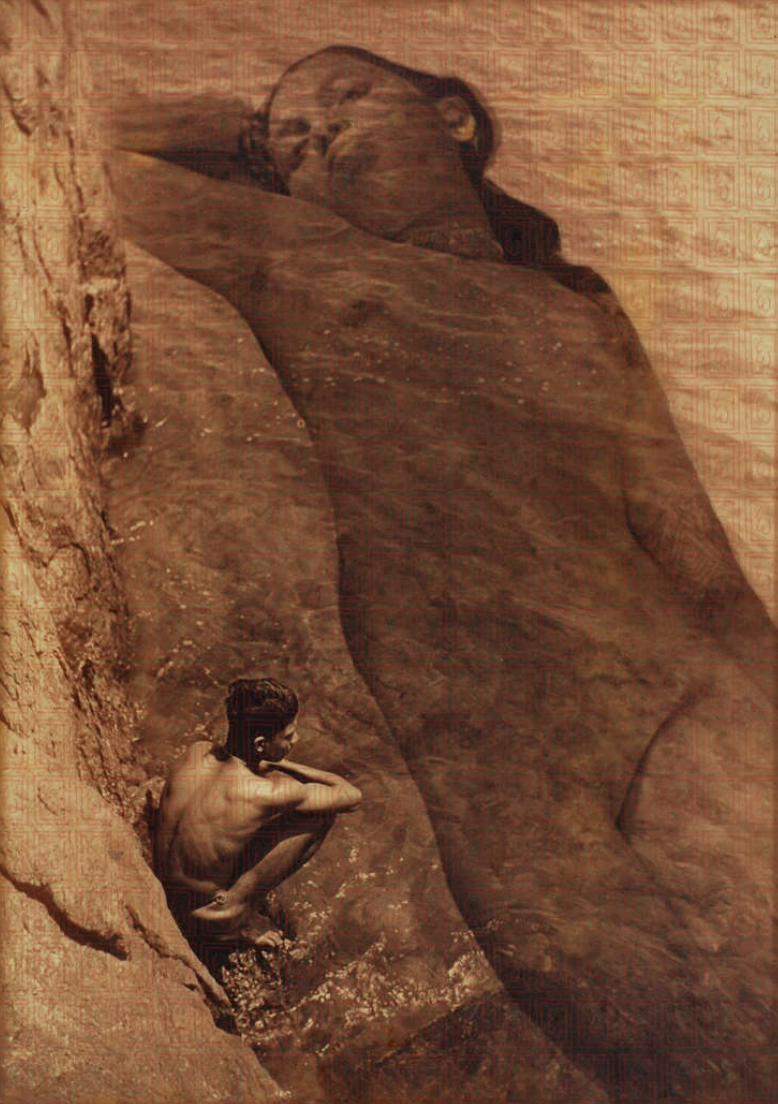P e a r l D i v e r s
i n t h e I n d i a n O c e a n

Podcast
I chose this picture to analyze for three reasons:
Something else that took my attention was the size of the photograph which is 585x430 mm, slightly more than half a meter. The size matters because it means the photographers thought highly of the picture and wanted the audience to be aware of the details by zooming in the picture by making the size bigger. The size also makes the photograph feel more like a painting since it is known that the woman was edited or “painted’ as the sea, she was not actually there when the picture was taken, because well women aren't that tall. It is important to note from the podcast, how the sea in Tamil culture was a goddess, and how even the technique of photography producing involved the use of pearls. This picture in itself as a primary source can be used in the same scientific way as geological measuring after a volcanic eruption is used; in an eruption, the lava brings out buried minerals and rocks from the past which are used to dissect time, natural phenomena, and historical facts. Similarly, digging into this photograph from the past, lets us be aware of the timeline, the techniques used to create it, and the historical and cultural significance. I call it an internet research eruption. It is important to bring up the notion of scientific translation, and how science can be communicated and translated into picture essays, instead of written papers and analyses. Or how the photograph is trying to capture and translate visually, what is the life of people and a community he is not a part of - Lionel Wendt was from Sri Lanka, he came from a family of mixed descendants of European settlers, and studied law in London. The picture was taken during the British occupation of 1930-1940
- The presence of the sea
- The man looking pensively at the sea
- The portrayal of the woman in the sea, knowing well how the sea is seen as a feminine entity because of the mystery around it, the destructive moods, and the seductiveness of its presence.
Something else that took my attention was the size of the photograph which is 585x430 mm, slightly more than half a meter. The size matters because it means the photographers thought highly of the picture and wanted the audience to be aware of the details by zooming in the picture by making the size bigger. The size also makes the photograph feel more like a painting since it is known that the woman was edited or “painted’ as the sea, she was not actually there when the picture was taken, because well women aren't that tall. It is important to note from the podcast, how the sea in Tamil culture was a goddess, and how even the technique of photography producing involved the use of pearls. This picture in itself as a primary source can be used in the same scientific way as geological measuring after a volcanic eruption is used; in an eruption, the lava brings out buried minerals and rocks from the past which are used to dissect time, natural phenomena, and historical facts. Similarly, digging into this photograph from the past, lets us be aware of the timeline, the techniques used to create it, and the historical and cultural significance. I call it an internet research eruption. It is important to bring up the notion of scientific translation, and how science can be communicated and translated into picture essays, instead of written papers and analyses. Or how the photograph is trying to capture and translate visually, what is the life of people and a community he is not a part of - Lionel Wendt was from Sri Lanka, he came from a family of mixed descendants of European settlers, and studied law in London. The picture was taken during the British occupation of 1930-1940
Poem
“His town alone
is adorned by the sea
where a fish-eating crane
disdains the blue lilies
in the marshy reaches
near the water,
and nests in a fresh seaside grove,
and even greater than that sea
is his love for us.
185. That small girl
with the beautiful filed bangles,
her red lips with teeth
like the glinting pearls
strewn at the mouth
of Koṟkai’s ghat,
where the petals
of blue lilies swing—
her sweet speech
is like the resonant strings
of a lute.
